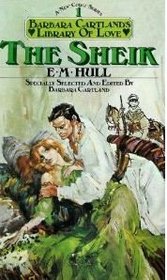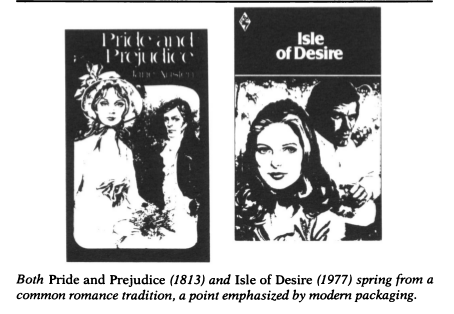Sunita made me aware of a 1978 article by John G Cawelti, author of Adventure, Mystery and Romance: Formula Stories as Art and Popular Culture (1976). In it, Cawelti states that "the romance tradition originated in the 18th century with writers like Samuel Richardson" (104) and thus
Contemporary portrayers of the tender passions can trace their craft back in an unbroken line to at least the middle of the 18th century. By contrast, the Western did not begin until James Fenimore Cooper's first "Leatherstocking" novel in 1823, while there was nothing that could really be called a detective story until Edgar Allen Poe's Dupin tales of the 1840s. Science-fiction enthusiasts claim an ancestry going back to ancient times, but the earliest fantasy with most of the characteristics of modern SF was Mary Shelley's Frankenstein of 1818. The spy thriller is of even more recent origin, emerging around World War I. (103)
He adds that "Jane Austen's Pride and Prejudice [...] (1813) is one of the archetypal models for romance fiction" (106) and to illustrate his point (literally) there's this:
Even in the original the pictures are fairly small and not very clear but they do enable a reader to see how, in the 1970s, the cover art for at least one edition of Pride and Prejudice could, as Cawelti says, be taken as an indication that it and the Harlequin romance "spring from a common romance tradition."
[Edited to add: I haven't been able to work out when that edition of Pride and Prejudice was published. Has anyone seen it before? ]
[Edited to add some more: Since Cartland's been mentioned in the comments, here's the cover chosen for her "Library of Love" reprint (I think from 1977) of E. M. Hull's The Sheik (originally published in 1919).

-----
Cawelti, John. "Romance: The Once and Future Queen." The Wilson Quarterly 2.3 (1978): 102-109.


Without knowing when that
Without knowing when that edition was published, I don't think any conclusions can be drawn, because who knows which came first? P&P being packaged to look like a genre romance would not be surprising. I've seen all kinds of editions of serious literary fiction packaged that way -- my original paperback of <i>Ella Price's Journal</i> is a prime example. (Sadly, I can't find an image of it online.)
There have been a lot of
There have been a lot of editions of P&P, as I discovered when I went looking. Here are just a few of them. This 1960s one is described as "Pride and Prejudice as a pop culture romance." That's from the slideshow attached to an article by Janine Barchas and she suggests that, "Perhaps more than anything else, these covers show what matters to prospective buyers."
I interpret Cawelti to be
I interpret Cawelti to be using the covers as additional corroboration for his argument that P&P and Harlequins spring from a common romance tradition (as do gothics and the Woodiwiss et al. novels, which he calls "women's fiction" in the piece). He makes the argument for P&P as the "archetypal model" for romance fiction in greater detail earlier in the article, emphasizing the plot, the relationship, and the way the hero is characterized and presented. The covers are illustrating his point, in my opinion, rather than being necessary to making it.
Re: the cover, the font looks really familiar, as does the overall design, but I can't place it. Doing an image search for P&P covers brings up a number of attempts to make the book look genre-friendly, including one in a pulp style with the tagline "Darcy's back in town."
Yes, I agree he's "using the
Yes, I agree he's "using the covers as additional corroboration for his argument." Thanks for the summary!
Still, Willaful raises an important point: they might have been marketed to later readers as romances primarily because the publishers spotted a hitherto untapped market among readers of romance. I remember that relatively recently there have been attempts by publishers to tap into the large and lucrative romance-reading market by sticking the "romance" label on books which might otherwise have been classified as paranormal/urban fantasy.
Mind you, I don't think those attempts ended particularly well. As I recall, a lot of romance readers were very angry they'd been tricked into buying books/series which didn't have a central romance/a central romance with a happy ending for the main couple.
I'm not sure how the 1970s romance readers felt about Austen packaged as romance but Lillian S. Robinson, who spent quite some time in a 1977 article "On Reading Trash" outlining why "Jane Austen is a better writer than Georgette Heyer" (220) nonetheless begins her penultimate paragraph with:
Austen's novels do have the various elements that romance readers expect to find in a romance. [Edited to add: by which I mean the various core elements. Obviously they don't have sex scenes of the kind one can find in many/most modern romances.]
-------
Robinson, Lillian S. "On Reading Trash." 1978. Sex, Class, and Culture. New York: Methuen, 1986. 200-222.
I remember reading something
I remember reading something about Heyer in which the author said she and her friends excused their passion for Heyer as acceptable because they'd "run out of Austen."
I haven't come across that
I haven't come across that quote, but I think I've got that vibe from a few people in the past. Heyer isn't as august as Austen, of course, but she seemed to be far more respectable than Barbara Cartland or Harlequin/Mills & Boon. I wonder if it's partly because readers could say they were reading Heyer for the humour. Heyer's historical accuracy is often mentioned too.
To add further craziness to
To add further craziness to the proposition, the P&P cover looks a lot like Barbara Cartland books of that era to me.
Also Laura, I love this sentence from Lillian S. Robinson
In both its high and popular avatars, this sort of novel centers on the private concerns of women, domestic, marital, and personal. [...] Both novelists [...] are saying that the personal matters.
That quote makes it worth
That quote makes it worth reading through the many pages in which Robinson hammers home why she doesn't think Heyer is as good as Austen.
I had a feeling Cartland might have brought out editions of classics so I did a quick search for those but couldn't find anything about Austen. Her "Library of Love" editions did include Ethel M. Dell's Greatheart (1918), "which was republished in 1978 in Cartland’s Library of Love series" (Rix) and E. M. Hull's The Sheik.
[Edited to add: I've added a picture of the cover of the Cartland edition of The Sheik to the original post.]
-----
Rix, Robert W. "‘Love in the Clouds’: Barbara Cartland’s Religious Romances.” Journal of Religion and Popular Culture 21.2 (2009).